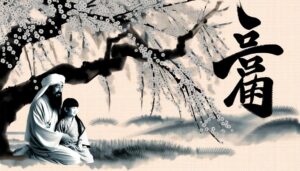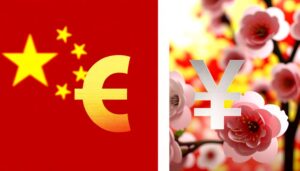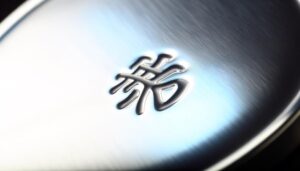What Is the Chinese Symbol for Music?
The Chinese symbol for music is represented by the characters 乐 (yuè) and 音 (yīn). These symbols trace back to ancient inscriptions, highlighting music's integral role in rituals and governance during the Shang and Zhou dynasties.
The character 乐 (yuè) combines phonetic and semantic components symbolizing wood and purity of sound, reflecting traditional values of harmony and balance. The term 音 (yīn) signifies acoustic harmony, deeply ingrained in Chinese literature and pop culture.
This rich etymology and cultural context link music to Confucian, Daoist, and Buddhist philosophies, underscoring its enduring significance in Chinese society. Explore further to uncover the full depth of this cultural tapestry.

Key Takeaways
- The Chinese symbol for music is '乐' (yuè).
- The character '乐' originates from ancient oracle bones and bronze vessels.
- '乐' symbolizes harmony, balance, and human experience in Chinese culture.
- Historically, '乐' was essential in rituals, ceremonies, and social governance.
- '乐' continues to influence modern Chinese literature, digital media, and pop culture.
Historical Origins

The historical origins of the Chinese symbol for music, 樂 (yuè), can be traced back to ancient inscriptions on oracle bones and bronze vessels from the Shang and Zhou dynasties. These early inscriptions provide valuable insights into the cultural significance of music in ancient Chinese society.
During the Shang dynasty (1600-1046 BCE), music was integral to rituals and ceremonies, often associated with communication with ancestors and deities. As civilization advanced into the Zhou dynasty (1046-256 BCE), the symbol evolved, reflecting a sophisticated understanding of music's role in both governance and social harmony.
The reverence for music is evident in the meticulous craftsmanship of these artifacts, underscoring its profound influence on Chinese cultural and spiritual life.
Etymology and Structure
The character for music in Chinese, 樂 (yuè), has a rich etymology rooted in ancient script and cultural significance. Historically, it can be traced back to oracle bone inscriptions, reflecting its longstanding prominence in Chinese civilization.
Structurally, the character itself comprises a combination of phonetic and semantic components, with 木 (mù) symbolizing wood, indicating the importance of musical instruments made from this material, and 白 (bái) suggesting purity or clarity of sound.
Historical Origins Explained
Tracing the historical origins of the Chinese character for music (乐, yuè) reveals a rich tapestry of cultural and linguistic evolution, intricately tied to ancient Chinese ritual practices and philosophical traditions.
Originally, the character 乐 depicted a musical instrument, symbolizing the integral role of music in Confucian ideals of harmony and societal order. During the Zhou Dynasty (1046–256 BCE), music was considered a conduit for moral and spiritual cultivation.
The character evolved through various script forms, from oracle bone inscriptions to bronze script and later to its modern form. Each transformation reflects shifts in artistic style and cultural priorities, showcasing the deep-seated respect for music in shaping Chinese civilization's ethical and aesthetic foundations.
Character Breakdown
Delving into the etymology and structure of the Chinese character for music (乐, yuè) reveals a complex interplay of phonetic and semantic components that offer insights into its historical and cultural significance.
The character 乐 is composed of two primary elements: the radical 木 (mù), meaning 'wood,' and the component 白 (bái), meaning 'white' or 'clear.' The radical 木 suggests the traditional use of wooden musical instruments, while 白 implies purity and clarity of sound. This combination encapsulates the essence of traditional Chinese music, which values harmony and purity.
Additionally, the character 乐 is also used to denote 'joy' and 'happiness,' further emphasizing the intrinsic connection between music and emotional well-being in Chinese culture.
Phonetic Components Analysis
Understanding the phonetic components of the Chinese character for music (乐, yuè) provides a deeper appreciation of its linguistic intricacies and historical evolution.
The character 乐 is composed of two primary elements: the radical 丿 (piě), which implies a dynamic motion, and 白 (bái), meaning 'white' or 'pure.'
Historically, 乐 also carries the phonetic element 丿, suggesting a link to sounds associated with joy and pleasure.
The character's structure reflects its dual meanings: 'music' and 'happiness,' indicating the cultural intertwining of these concepts.
This multi-layered composition underscores the complexity of Chinese characters, where phonetic and semantic elements converge to convey rich, culturally embedded meanings, further illustrating the sophistication of the Chinese writing system.
Philosophical Meanings

In Chinese culture, the symbol for music (音乐, yīnyuè) transcends its literal meaning to embody profound philosophical concepts that resonate deeply within the domains of harmony, balance, and the human experience.
The ideogram represents more than auditory pleasure; it serves as a metaphor for life's essential rhythms and the universe's intrinsic order. This symbol intricately connects with Confucian, Daoist, and Buddhist philosophies, reflecting the following concepts:
- Harmony: Emphasizes the balance between contrasting elements, akin to musical notes forming a symphony.
- Unity: Symbolizes the interconnectedness of all things, mirroring the ensemble of musical instruments.
- Emotional Resonance: Captures the profound impact of music on the human spirit and emotions.
- Cosmic Order: Represents the alignment with the natural order and cosmic rhythms.
Understanding these layers enriches one's appreciation of Chinese philosophy.
Cultural Significance
Rooted in these philosophical underpinnings, the cultural significance of the symbol for music in Chinese society extends to various aspects of daily life, rituals, and artistic expressions. The symbol, denoted by the character 音 (yīn), signifies not just sound but harmony and balance, embodying the Confucian ideal of societal cohesion. Its application ranges from classical literature to modern media, reflecting its enduring presence.
```markdown
| Area of Influence | Description | Example |
|---|---|---|
| Literature | Symbolizes harmony and order | Classical poetry |
| Education | Integral part of moral teaching | Confucian curriculum |
| Social Rituals | Enhances ceremonial experiences | Weddings, festivals |
| Artistic Expression | Embodied in various art forms | Calligraphy, painting |
| Modern Media | Maintains cultural heritage | Music apps, TV shows |
```
The symbol's multifaceted role highlights its profound impact on Chinese culture.
Ancient Rituals
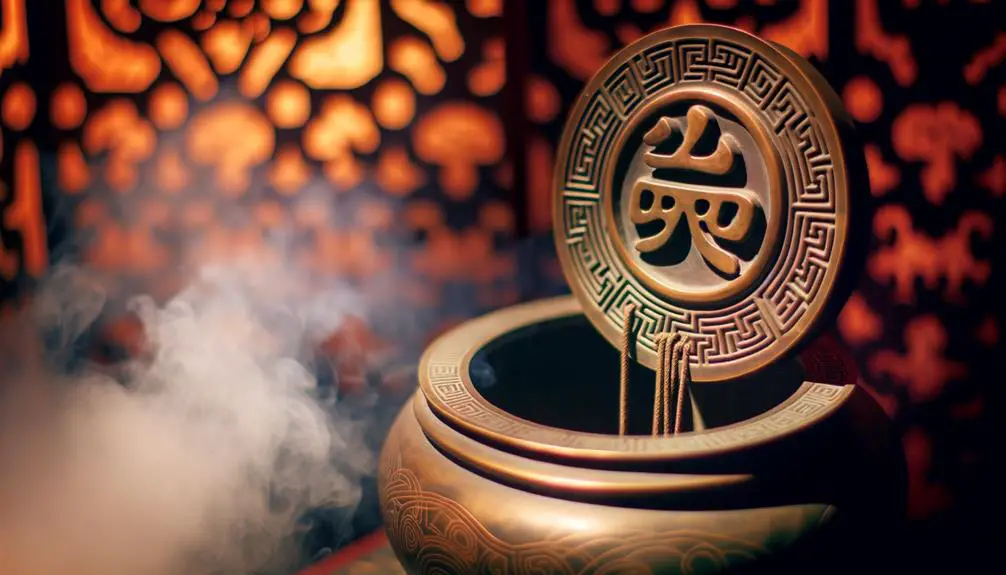
In ancient Chinese rituals, music held profound ceremonial significance, often serving as a conduit for communication with deities and ancestors.
The intricate roles of various traditional instruments, such as the guqin and the sheng, were meticulously orchestrated to evoke specific spiritual and emotional responses.
These practices underscore the symbiotic relationship between music and ritual, reflecting the deeply embedded cultural values of harmony and reverence.
Ceremonial Music Significance
How did ceremonial music attain such profound significance in ancient Chinese rituals, serving as a bridge between the earthly and the divine?
Ceremonial music in ancient China was deeply intertwined with cosmological beliefs and social hierarchies. It was not merely an aesthetic endeavor but a conduit for spiritual communication and societal order. Music was believed to harmonize human actions with celestial rhythms, thereby ensuring cosmic balance and divine favor.
Key elements of ceremonial music's significance include:
- Cosmic Harmony: Aligning human activities with universal principles.
- Social Order: Reinforcing hierarchical structures within society.
- Ritual Precision: Ensuring the accuracy and efficacy of rituals.
- Spiritual Communication: Facilitating dialogue between the mortal and immortal domains.
Understanding these aspects underlines the essential role of music in ancient Chinese ceremonial practices.
Instruments and Their Roles
An in-depth exploration of ancient Chinese rituals reveals that musical instruments were meticulously chosen and employed not only for their auditory qualities but also for their symbolic meanings and specific roles in ceremonial contexts.
The bianzhong, a set of bronze bells, was integral for invoking divine presence, symbolizing harmony between heaven and earth.
The guqin, a seven-stringed zither, was often played during sacrificial rites, embodying scholarly wisdom and moral refinement.
Meanwhile, the sheng, a mouth-blown free reed instrument, signified the harmonious breath of nature.
Each instrument contributed to the ritual's purpose, whether to communicate with ancestors, celebrate seasonal cycles, or uphold societal hierarchies, reflecting a profound intertwining of music, philosophy, and cosmology in ancient Chinese culture.
Influence on Literature
The symbol for music in Chinese, 音 (yīn), has profoundly permeated classical and contemporary literature, serving as a leitmotif that underscores the cultural and philosophical significance of harmony and rhythm in written works.
Esteemed poets and writers have utilized this symbol to evoke a sense of balance and beauty, reflecting the intertwined nature of sound and meaning.
- Classical poetry: The Tang and Song dynasties saw extensive use of 音 (yīn) to symbolize the harmony of nature and human sentiment.
- Philosophical texts: Confucian and Daoist writings often reference music to illustrate moral and cosmic order.
- Modern literature: Contemporary authors employ 音 (yīn) to explore themes of cultural identity and emotional resonance.
- Literary criticism: Scholars analyze the use of 音 (yīn) to understand deeper layers of textual harmony and rhythm.
Modern Interpretations
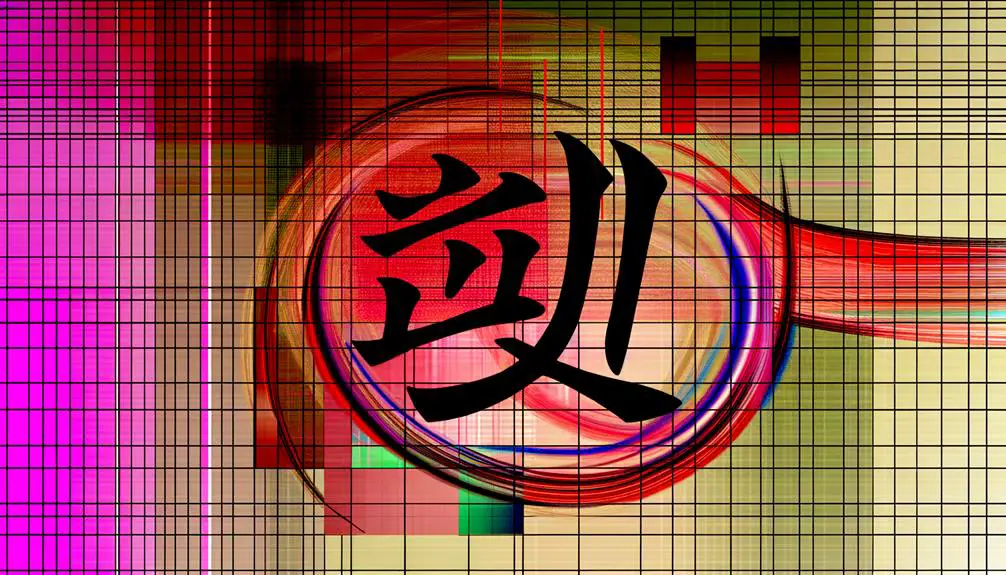
In contemporary contexts, the symbol 音 (yīn) has evolved to encapsulate a diverse array of interpretations, reflecting shifts in cultural paradigms and technological advancements.
The character, historically emblematic of sound and music, now intersects with digital media, interactive platforms, and global communication networks. Its usage extends beyond traditional music to encompass digital audio, streaming services, and multimedia production.
Scholars note that 音 has become a semiotic bridge, connecting ancient cultural heritage with modern auditory experiences. This evolution underscores a dynamic interaction between tradition and innovation, where 音 serves as a versatile symbol within educational curricula, linguistic studies, and technological applications.
Therefore, the symbol's modern interpretations reveal an intricate tapestry of historical continuity and contemporary relevance.
Symbol in Pop Culture
Building on its expanded role in modern contexts, the symbol 音 (yīn) has permeated various facets of pop culture, from music videos and album art to fashion and social media, symbolizing a rich confluence of artistic expression and cultural identity. This character, recognized for its deep roots in Chinese culture, has been adapted in contemporary settings, signifying the universal language of music.
- Music Videos: Prominently displayed in visuals to evoke cultural depth.
- Album Art: Utilized in designs to bridge traditional and modern aesthetics.
- Fashion: Featured on clothing and accessories, merging heritage with modern style.
- Social Media: Popularized through hashtags and emojis, fostering global connectivity.
The symbol 音 (yīn) stands as a tribute to the enduring power of music in human expression.
Comparative Analysis
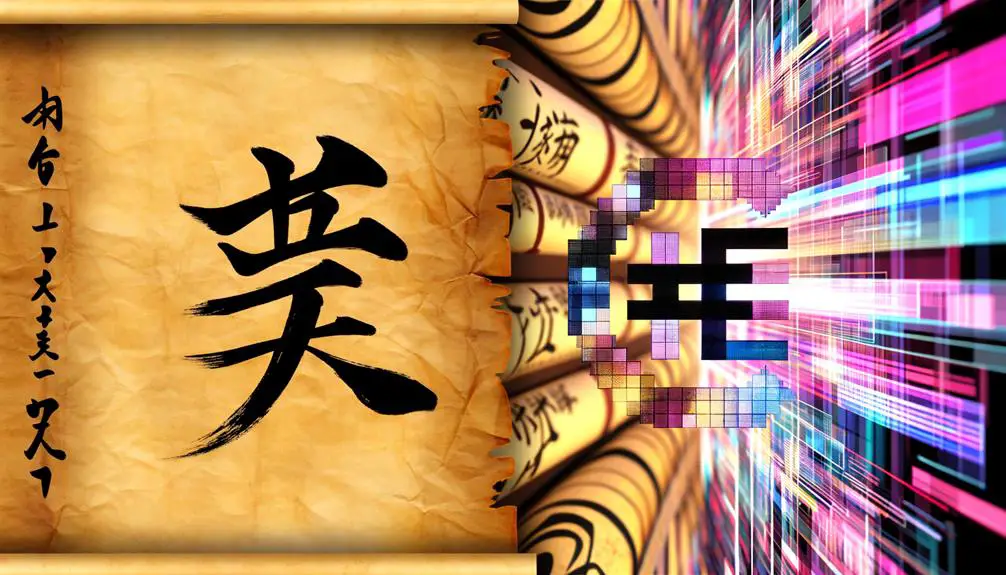
Examining the symbol 音 (yīn) within the context of Chinese culture versus its representation in Western pop culture reveals intriguing contrasts and intersections in the conceptualization and visual portrayal of music.
In Chinese culture, 音 (yīn) embodies a profound connection to harmony, nature, and the cosmological order, reflecting ancient philosophies that emphasize balance and resonance.
Conversely, Western pop culture often depicts music through symbols like the treble clef or musical notes, focusing on modernity, entertainment, and technological innovation.
This comparative analysis highlights how the Chinese symbol encapsulates broader, more traditional cultural values, while Western representations tend to emphasize individual artistic expression and the immediacy of popular trends.
Both perspectives enrich our global understanding of music.
Conclusion
The symbolic representation of music in Chinese culture transcends mere notation, embodying profound historical, philosophical, and cultural dimensions. Its ancient roots and intricate etymology reveal a tapestry of meanings that resonate through literature, rituals, and modern interpretations.
This symbol's enduring presence in both traditional and contemporary contexts underscores its timeless significance. Through a comparative analysis, one discerns that the Chinese symbol for music is not merely an artistic expression but a profound cultural artifact, perpetually echoing through the corridors of time.

